Honda just released the latest info on the 2020 Africa Twin and 2020 Africa Twin Adventure Sports SE models. Both are available in the traditional six-speed manual or DCT versions. But the big news here is that the second-generation Africa Twin engine is now 1,100cc thanks to an increased stroke, new semi-double-cradle steel frame, removable aluminum subframe, and new swingarm lead a list of chassis updates that help shave off more than 10 pounds while improving its overall performance.
Honda appears to be getting more comfortable with the rider assist technology these days too. The new Africa Twins features a seven-level Honda Selectable Torque Control (HSTC), six ride modes, wheelie control, engine-braking control, selectable cornering ABS (this was offered on the previous model), and it now comes with cruise control. All of these functions can be monitored and adjusted via the new 6.5-inch TFT touchscreen display which is compatible with Apple CarPlay. Where Honda seemed to avoid electronic gizmos on the first generation, this version has almost all of them.
Related: What We Love About The Honda Africa Twin CRF1000L And What We Hope To See Next
"Since the Africa Twin's 2016 rebirth, it's been gratifying to see riders gravitate to a practical-but-fun adventure bike," said Chris Cox, American Honda's manager of experiential marketing/public relations. "For 2020, Honda has amplified what customers appreciate most about the Africa Twin platform—its ability to go anywhere, whether that means safety and comfort on the road, or performance and maneuverability in the dirt. With a long list of important updates to both model types, riders will find even more ways to pursue 'True Adventure.' "
The big news for 2020 is a 86cc bump in displacement and the power boost that comes along with it. Basically, this is a stroked version of the same engine that now displaces 1,084cc and produces a claimed 100 hp at 7,500 rpm with 77.5 pound-feet of torque at 6,250 rpm. This equates to a 7 hp and 4 pound-feet increase over the 998cc version, which is not a huge gain. However, we must remember that Honda believes in making motorcycles with usable power and this longer stroke layout, combined with the 270-degree crank, should equate to more tractable power that will improve power delivery when riding off-road in particular.
Rider comfort is the next area that Honda addressed. The seat is 1.5 inches narrower and has a new contour that makes it easier for the rider to touch the ground, and seat height is adjustable on both models with a range of 33.5 to 34.3 inches. The new-look front fairing is narrower, has LED running lights, and also cornering lights for the Adventure Sports model. This is where the Adventure Sports SE version begins to differentiate itself from the off-road-focused base model.
The Adventure Sports SE is the touring version with long-range adventure riding in mind. The list of additional amenities includes a larger 6.5-gallon fuel tank, taller adjustable windscreen, large skid plate, rear storage rack, heated grips, and Showa Electronically Equipped Ride Adjustment (EERA) suspension. The EERA is designed around Showa’s Balance Free fork valve tech working with input from the Bosch IMU to provide the perfect suspension setting changes on the fly through any of four settings: Soft, Mid, Hard, and Off-road.
With the addition of electronic suspension combined with the fine-tuning deployed on the chassis and rider interface, the Africa Twin has evolved dramatically for 2020. Honda has clearly taken aim at the established uber-tourers, so 2020 is setting up to be a great year for the comparison that everybody has been hoping to see over the past four years.
The base-model Africa Twin ($14,399; DCT $15,199) will be available in Matte Black Metallic and the Adventure Sports SE ($17,199; DCT $17,999) will be offered in the Pearl Glare White and Blue versions only.










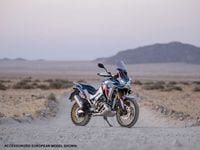
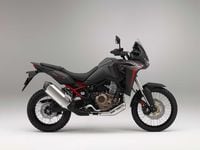


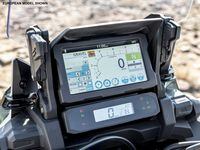

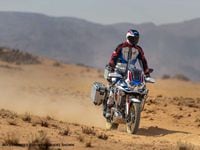

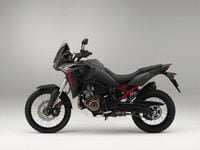
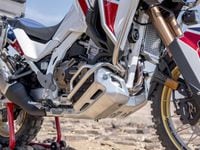

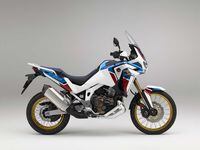
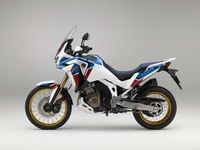

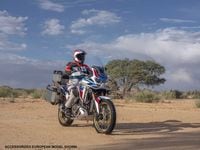
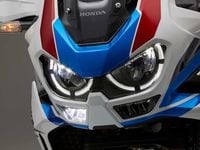

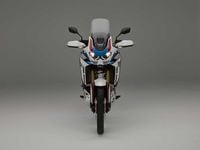
/cloudfront-us-east-1.images.arcpublishing.com/octane/TNOU5DNE2BC57MFPMGN2EIDXAM.jpg)
/cloudfront-us-east-1.images.arcpublishing.com/octane/GTCXACQGJ5HAPDTGWUQKDEH44E.jpg)
/cloudfront-us-east-1.images.arcpublishing.com/octane/S35YGSEMEZB4BLTDJTSZPF4GLA.jpg)
/cloudfront-us-east-1.images.arcpublishing.com/octane/5UOT6HPX2JFMRJAX6EH45AR4MQ.jpg)
/cloudfront-us-east-1.images.arcpublishing.com/octane/OKWOJWAKP5EP3OACCRRWPCIX2Q.jpg)
/cloudfront-us-east-1.images.arcpublishing.com/octane/2WF3SCE3NFBQXLDNJM7KMXA45E.jpg)
/cloudfront-us-east-1.images.arcpublishing.com/octane/G4MG6OUCJNBSHIS2MVVOTPX65E.jpg)
/cloudfront-us-east-1.images.arcpublishing.com/octane/IIGGWFOTOJGB7DB6DGBXCCMTDY.jpg)
/cloudfront-us-east-1.images.arcpublishing.com/octane/QSTCM6AVEZA5JJBUXNIQ3DSOF4.jpg)
/cloudfront-us-east-1.images.arcpublishing.com/octane/U4I7G625B5DMLF2DVIJDFZVV6M.jpg)
/cloudfront-us-east-1.images.arcpublishing.com/octane/B6XD6LS6IVCQPIU6HXDJSM3FHY.jpg)
/cloudfront-us-east-1.images.arcpublishing.com/octane/ICL63FEDDRDTTMINYICCEYGMDA.jpg)
/cloudfront-us-east-1.images.arcpublishing.com/octane/FCGZHQXRBZFLBAPC5SDIQLVF4I.jpg)
/cloudfront-us-east-1.images.arcpublishing.com/octane/WNOB6LDOIFFHJKPSVIWDYUGOPM.jpg)

/cloudfront-us-east-1.images.arcpublishing.com/octane/X33NU3E525ECRHXLNUJN2FTRKI.jpg)
/cloudfront-us-east-1.images.arcpublishing.com/octane/6KKT5NNL2JAVBOXMZYS5ZO76YA.jpg)
/cloudfront-us-east-1.images.arcpublishing.com/octane/J5RKG5O455GMPGQRF2OG6LRT7A.jpg)
/cloudfront-us-east-1.images.arcpublishing.com/octane/GX2CIZKQVRH2TATDM26KFG2DAE.jpg)
/cloudfront-us-east-1.images.arcpublishing.com/octane/ZWIDYSAKQZHD5BHREMQILXJCGM.jpg)
/cloudfront-us-east-1.images.arcpublishing.com/octane/CYUHJZCTSJCH3MRAQEIKXK7SCQ.jpg)
/cloudfront-us-east-1.images.arcpublishing.com/octane/LKOFINY56FCXJCANJ5M7ZDQUBY.jpg)
/cloudfront-us-east-1.images.arcpublishing.com/octane/4NBPDACMWJH63JQYJVK3QRBDZI.jpg)
/cloudfront-us-east-1.images.arcpublishing.com/octane/KKHQHRR3FJGX7H2IPU6RALMWG4.jpg)